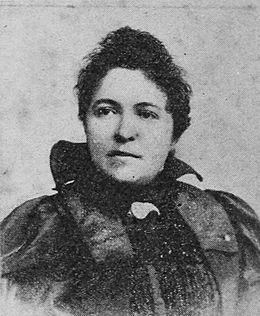Nationality French Grandparent François-Marie Gagneur | Known for sculpture | |
 | ||
Born 10 August 1857 Bréry, Jura Died 21 May 1945, Paris, France Artwork Victor Schœlcher, Vision, Frédéric Cournet, Sappho sleeping, Victor Considerant Parents Wladimir Gagneur, Louise Gagneur People also search for Wladimir Gagneur, Louise Gagneur, François-Marie Gagneur | ||
Marguerite Syamour, pseudonym Marguerite Gagneur (10 August 1857 at Bréry (Jura) - 21 May 1945 Paris) was a French sculptor.
Contents
She is the author of many sculptures, most of which are located in the municipalities of Jura (Saint Claude, Poligny, Saint-Lothain, Châtelneuf), or in museums in Cambrai, Grenoble and Besançon, or at Père-Lachaise (tomb of Frédéric Cournet).
Life
Her father Wladimir Gagneur, was born in Poligny, Jura in 1807, was a lawyer, journalist and politician,and follower of Charles Fourier. He defended of the Republic at the time of the coup of 2 December 1851, and was banned by the empire. Back in France, he married Marie-Louise Mignerot (1832-1902), feminist and writer. Their daughter Margaret was born August 10, 1857 at Bréry near Poligny, and Jules Grevy, a fellow student of his father in Dole, was her godfather. Wladimir Gagneur Jura was an activist of the Republican Left, and was elected MP in 1869 and remained until his death in 1889. Margaret is also deeply attached to republican values of social progress and émancipation.
She married with Ernest Gegout in Paris on 31 July 1879;2 they divorced in 1887.
She chose to become an artist and forms in the workshop of Antonin Mercie (1845-1916) Fourierist aussi4 him. Marguerite Gagneur artistic career began in 1884 under the pseudonym "Syamour" contraction "Syam" Jura village, and the word "love".
From 1890, she lived in Paris with her mother, at 6, rue du Val de Grace, close to Montparnasse, and set up her studio not far away rue d'Assas. She befriended her neighbor, the Czech painter and poster artist Alfons Mucha (1860-1939), for whom she posed: he will make her a lithograph: Primrose (1899) and was recognized as Marguerite in other works of Mucha without toutefois6 certainty. Her salon welcomed artists, politicians and occultists as Colonel Rochas. It also alongside other personalities like the famous explorer Pierre Savorgnan de Brazza.
After the death of her mother in February 1902, Syamour remarriesd on 12 November 1902 with Jean-Gérard Fréchout, a doctor in Salins-les-Bains (Jura). She then partnered with Victor Poupin, anticlerical journalist, general counsel of Champagnole and MP of the radical left, she shares her life at his home in Chatelneuf until his death in 1906.
She then worked in Paris and participates in various exhibitions, including in 1912. Her career ended with the 1914 war but still lives a long time, dying in Paris on 21 May 1945. She was cremated and her ashes are deposited in the columbarium the Père-Lachaise (box 6345) in Paris with the inscription "Ms. SYAMOUR / Marguerite Fréchou-Gagneur / Sculptor-sculpture / 1857-1945."
Career
Syamour exhibited at the Salon of French artists between 1885 and 1912, and the Champs Elysees Fair, the Galerie Georges Petit and the Universal Exhibition of 1900. Many of his works were acquired by the State and she was involved in the development of various public monuments especially in Jura.
Her work offers both realism as evidenced busts of his contemporaries and symbolism in the conventional embodiment of allegories which perceives its feminine sensibility like Aurora or lying naked asleep Sappho. Her works also show her Republican and Fourierist commitment: various Mariana - bust of Frederick Cournet, communard - Charles Fourier, the utopian socialist - Victor Considerant, socialist and republican thinker - Victor Schoelcher, initiator of the abolition of slavery, or in the monument to Voltaire and Cristin St. Claude (destroyed in 1942). Attached to her native Jura, she paid tribute to the Franche-Comté personalities left like his father Wladimir Gagneur or Charles Sauria, the inventor of allumettes.
